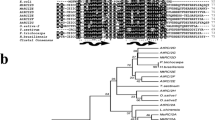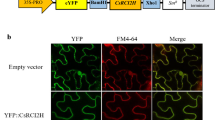Abstract
For plant salt tolerance, it is important to regulate the uptake and accumulation of Na+ ions. The yeast pmp3 mutant which lacks PMP3 gene accumulates excess Na+ ions in the cell and shows increased Na+ sensitivity. Although the function of PMP3 is not fully understood, it is proposed that PMP3 contributes to the restriction of Na+ uptake and consequently salt tolerance in yeasts. In this paper, we have investigated whether the lack of RCI2A gene, homologous to PMP3 gene, causes a salt sensitive phenotype in Arabidopsis (Arabidopsis thaliana (L.) Heynh.) plants; and to thereby indicate the physiological role of RCI2A in higher plants. Two T-DNA insertional mutants of RCI2A were identified. Although the growth of rci2a mutants was comparable with that of wild type under normal conditions, high NaCl treatment caused increased accumulation of Na+ and more reduction of the growth of roots and shoots of rci2a mutants than that of wild type. Undifferentiated callus cultures regenerated from rci2a mutants also accumulated more Na+ than that from wild type under high NaCl treatment. Furthermore, when wild-type and rci2a plants were treated with NaCl, NaNO3, Na2SO4, KCl, KNO3, K2SO4 or LiCl, the rci2a mutants showed more reduction of shoot growth than wild type. Under treatments of tetramethylammonium chloride, CaCl2, MgCl2, mannitol or sorbitol, the growth reduction was comparable between wild-type and rci2a plants. These results suggested that RCI2A plays a role directly or indirectly for avoiding over-accumulation of excess Na+ and K+ ions in plants, and contributes to salt tolerance.





Similar content being viewed by others
Abbreviations
- ABA:
-
Abscisic acid
References
Akita S, Cabuslay GS (1990) Physiological basis of differential response to salinity in rice cultivars. Plant Soil 123:277–294
Alonso JM, Stepanova AN, Leisse TJ et al (2003) Genome-wide insertional mutagenesis of Arabidopsis thaliana. Science 301:653–657
Blumwald E (2000) Sodium transport and salt tolerance in plants. Curr Opin Cell Biol 12:431–434
Capel J, Jarillo JA, Salinas J, Martinez-Zapater JM (1997) Two homologous low-temperature-inducible genes from Arabidopsis encode highly hydrophobic proteins. Plant Physiol 115:569–576
Church GM, Gilbert W (1984) Genomic sequencing. Proc Natl Acad Sci USA 81:1991–1995
Demidchik V, Tester M (2002) Sodium fluxes through nonselective cation channels in the plasma membrane of protoplasts from Arabidopsis roots. Plant Physiol 128:379–387
Galvez AF, Gulick PJ, Dvorak J (1993) Characterization of the early stages of genetic salt-stress responses in salt-tolerant Lophopyrum elongatum, salt-sensitive wheat, and their amphiploid. Plant Physiol 103:257–265
Gaxiola RA, Li J, Undurraga S, Dang LM, Allen GJ, Alper SL, Fink GR (2001) Drought- and salt-tolerant plants result from overexpression of the AVP1 H+-pump. Proc Natl Acad Sci USA 98:11444–11449
Goddard NJ, Dunn MA, Zhang L, White AJ, Jack PL, Hughes MA (1993) Molecular analysis and spatial expression pattern of a low-temperature-specific barley gene, blt101. Plant Mol Biol 23:871–879
Greenway H, Munns R (1980) Mechanisms of salt tolerance in nonhalophytes. Annu Rev Plant Physiol 31:149–190
Hallick RB, Chelm BK, Gray PW, Orozco EMJ (1977) Use of aurintricarboxylic acid as an inhibitor of nucleases during nucleic acid isolation. Nucleic Acids Res 4:3055–3064
Inada M, Ueda A, Shi W, Takabe T (2005) A stress-inducible plasma membrane protein 3 (AcPMP3) in a monocotyledonous halophyte, Aneurolepidium chinense, regulates cellular Na+ and K+ accumulation under salt stress. Planta 220:395–402
Kroemer K, Reski R, Frank W (2004) Abiotic stress response in the moss Physcomitrella patens: evidence for an evolutionary alteration in signaling pathways in land plants. Plant Cell Rep 22:864–870
Maathuis FJM, Amtmann A (1999) K+ nutrition and Na+ toxicity: the basis of cellular K+/Na+ ratios. Ann Bot 84:123–133
McGookin R (1984) RNA extraction by the guanidine thiocyanate procedure. In: Walker JM, Clifton NJ (eds) Methods in molecular biology, vol 2. Humana Press, Totowa, pp 113–116
Medina J, Catala R, Salinas J (2001) Developmental and stress regulation of RCI2A and RCI2B, two cold-inducible genes of Arabidopsis encoding highly conserved hydrophobic proteins. Plant Physiol 125:1655–1666
Mitsuya S, Kawasaki M, Taniguchi M, Miyake H (2003a) Light dependency of salinity-induced chloroplast degradation. Plant Prod Sci 6:219–223
Mitsuya S, Kawasaki M, Taniguchi M, Miyake H (2003b) Relationship between salinity-induced damages and aging in rice leaf tissues. Plant Prod Sci 6:213–218
Morsy MR, Almutairi AM, Gibbons J, Yun SJ, de los Reyes BG (2005) The OsLti6 genes encoding low-molecular-weight membrane proteins are differentially expressed in rice cultivars with contrasting sensitivity to low temperature. Gene 344:171–180
Munns R (2002) Comparative physiology of salt and water stress. Plant Cell Environ 25:239–250
Navarre C, Goffeau A (2000) Membrane hyperpolarization and salt sensitivity induced by deletion of PMP3, a highly conserved small protein of yeast plasma membrane. EMBO J 19:2515–2524
Nylander M, Heino P, Helenius E, Palva T, Ronne H, Welin BV (2001) The low-temperature- and salt-induced RCI2A gene of Arabidopsis complements the sodium sensitivity caused by a deletion of the homologous yeast gene SNA1. Plant Mol Biol 45:341–352
Qiu Q-S, Guo Y, Dietrich MA, Schumaker KS, Zhu J-K (2002) Regulation of SOS1, a plasma membrane Na+/H+ exchanger in Arabidopsis thaliana, by SOS2 and SOS3. Proc Natl Acad Sci USA 99:8436–8441
Rahman MS, Matsumuro T, Miyake H, Takeoka Y (2001) Effects of salinity stress on the seminal root tip ultrastructures of rice seedlings. Plant Prod Sci 4:103–111
Rubio F, Gassmann Q, Schroeder JI (1995) Sodium-driven potassium uptake by the plant potassium transporter HKT1 and mutations conferring salt tolerance. Science 270:1660–1663
Sambrook J, Russell DW (2001) Molecular cloning: a laboratory manual, 3rd edn. Cold Spring Harbor Laboratory Press, New York
Shinozaki K, Yamaguchi-Shinozaki K (2000) Molecular responses to dehydration and low temperature: differences and cross-talk between two stress signaling pathways. Curr Opin Plant Biol 3:217–223
Somerville CR, Ogren WL (1982) Isolation of photorespiration mutants in Arabidopsis thaliana. In: Edelman M, Hallick RB, Chua NH (eds) Methods in chloroplast biology. Elsevier Biomedical Press, New York, pp 129–138
Szabolcs I (1994) Soils and salinisation. In: Pessarakali M (ed) Handbook of plant and crop stress. Marcel Dekker, New York, pp 3–11
Venema K, Quintero FJ, Pardo JM, Donaire JP (2002) The Arabidopsis Na+/H+ exchanger AtNHX1 catalyzes low affinity Na+ and K+ transport in reconstituted liposomes. J Biol Chem 277:2413–2418
Vitart V, Baxter I, Doerner P, Harper JF (2001) Evidence for a role in growth and salt resistance of a plasma membrane H+-ATPase in the root endodermis. Plant J 27:191–201
Wilkinson M, Doskow J, Lindsey S (1991) RNA blots: staining procedures and optimization of conditions. Nucleic Acids Res 19:679
Wu S-J, Ding L, Zhu J-K (1996) SOS1, a genetic locus essential for salt tolerance and potassium acquisition. Plant Cell 8:617–627
Acknowledgements
We thank the Arabidopsis Biological Resource Center (ABRC) for providing seed stocks, Dr. K. Yano (Nagoya University, Japan) for the use of an atomic absorption spectrometer, and Dr. A. T. Jagendorf (Cornell University, USA) for critical reading the manuscript and helpful discussions. This work was supported by Research Fellowships of the Japan Society for the Promotion of Science for Young Scientists (to S.M.).
Author information
Authors and Affiliations
Corresponding author
Rights and permissions
About this article
Cite this article
Mitsuya, S., Taniguchi, M., Miyake, H. et al. Disruption of RCI2A leads to over-accumulation of Na+ and increased salt sensitivity in Arabidopsis thaliana plants. Planta 222, 1001–1009 (2005). https://doi.org/10.1007/s00425-005-0043-9
Received:
Accepted:
Published:
Issue Date:
DOI: https://doi.org/10.1007/s00425-005-0043-9




